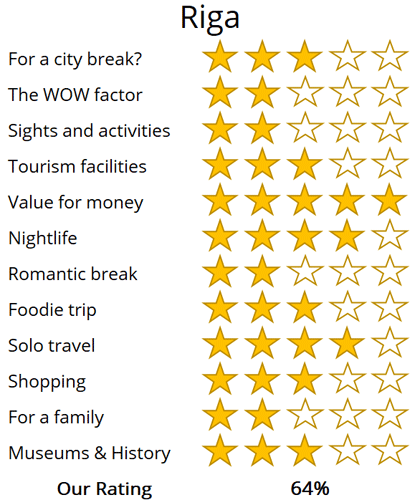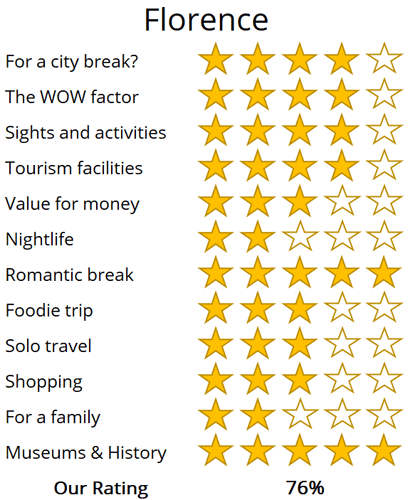WhereToGoForMyHoliday.com
The best destination comparison site!
WhereToGoForMyHoliday.com
The best destination comparison site!
Riga or Florence, which is better for your holiday in 2024?
Florence and Riga both offer unique and enticing experiences, but which one should you choose for your city break or holiday?
We understand your dilemma. There is an abundance of travel guides for both cities, but few actually comparing them, and advising you which is the better for your trip.
This article will provide our unbiased and independent views of Florence and Riga, hopefully making your choice that little easier.
The article is structured into several sections, each of which can be directly accessed through the following links:
• Introduction to the cities
• Scores and ratings
• Which one should I, friends, or family visit?
• When to visit and weather
• Who is the city suited for?
• The perfect 48hours (with map)
• Tourism details (where to stay? airport details?)
Introduction to Riga and Florence
Florence comes at you in a flurry of priceless art, pastel-painted jewellers, romantic piazzas, marble-gilded basilicas, and saffron-scented risotto. Nestled into the rolling Arezzo hills in the northern part of Tuscany, this is the very birthplace of the European Renaissance.
Florence flows in its 15th-century brilliance; there’s the Uffizi Gallery - home to works by Michelangelo and Sandro Botticelli - and the handsome Ponte Vecchio bridge.
Delve beneath the famed sights and Florence is a lived-in Italian metropolis. Locals devour lampredotto sarnies while glugging Chianti reds in hidden trattoria.
Florence’s allure is as classical as the city itself, but be warned you will be sharing the experience with many others, as there will be crowds!

The Swedish Gate one of the original gates in Riga’s fortifications
Riga is a cool and collected Baltic capital Bridging both sides of the Daugava River estuary, its laid-back districts effortlessly flit from elegant Art Nouveau to stoic northern cottages built from wood.
But it's the Old Town area that really draws the eye. That's a web of cobbled alleys and hidden squares. Onion domes and Gothic belfries loom overhead in those parts, and hearty Latvian taverns slosh with beers and burst with dumplings in cellars beneath the flagstones.
Be warned that Riga has developed a reputation for stag and hen do weekending. If you travel during the summer, you're likely to encounter at least one group of boozed-up Brits.
But that shouldn't put you off. There are enough craft beer joints, bohemian cafes, and restaurants to go around. What's more, the old guild houses and haunting churches can balance the experience out with a dollop of culture and history.

Riga castle stands along the Daugava River
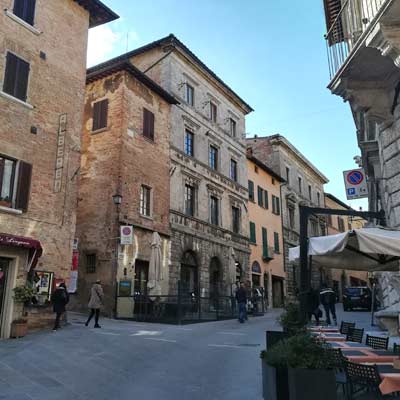
Every street in Florence is characterful
Riga vs Florence: City Ratings
Summary
Where would I journey for a personal escape?
Florence
Where would I send my parents for a memorable visit?
Florence
Where's the ideal destination for my adventurous 19-year-old cousin?
Riga
Where should my food-obsessed friend indulge their culinary passions?
Florence
Note: The above comparisons are weather-independent and are based on travel during the most opportune times of the year. Details about the ideal travel seasons are elaborated upon later in this article.
In the sections that follow, you'll find a comprehensive comparison between these two fascinating cities. This includes recommendations on the duration of stay, the best times to visit, and tailored 48-hour itineraries for each city.
The final segment delves into practicalities for your travels, such as the best airport to fly into, the optimal districts for your accommodation, and insider tips, for when you come to explore the city.
We hope that you find all of this information useful, in planning your next exciting trip!
Destination details
How long to spend each city?
Riga might be the largest of the three Baltic capitals, but it's still a relatively small city. You can get from end to end in less than 40 minutes in the car, while the districts that are of interest to travellers are all within walking distance of each other.
That helps if you're only planning a short weekend away. Fly-in, fly-out city breaks are totally doable. In fact, a couple of days is what the majority of travellers come for.
If you want to explore for longer, you might want to come during the summertime. Not only can the winters here get downright cold (more on that later), but Riga is close to the some of the most celebrated beach resorts on the whole Baltic coast.
Florence demands at least two days. Lovers of this enchanting town will surely scoff at that. They wax lyrical about how Florence seduces folk who pass its way into staying weeks, months, years, and even whole lifetimes. Still, we think it's possible to check off the main sights, try the top dishes, and explore the historic center with around 48-72 hours total.
In the peak season there are extremely long queues for the galleries and Duomo cathedral; to avoid wasting precious time, it is advisable to pre-purchase tickets and start the day sightseeing very early (before 8am).
There are many good day trips from Florence, which are easily accessible by train, and include Siena, Lucca, and Arezzo. Florence may be a smaller city, but a fabulous one-week holiday could be had based here.

The skyline of central Riga, with Riga cathedral at the centre
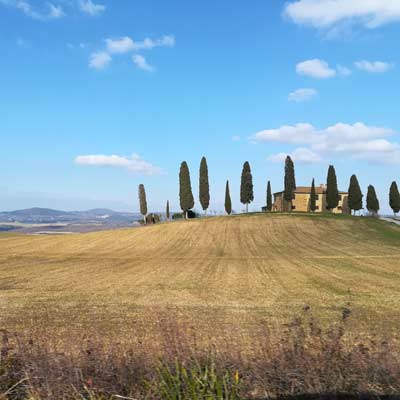
Tuscany is a beautiful region to discover
The Baltic summers are a tamer version of the warm season in the south of the continent. It's pleasant here when the temperature squeezes into the low 20s. Then, Riga goes al fresco in earnest.
The cafes on the main squares in the Riga Old Town buzz with life and chatter. There are students and backpackers sharing stories in the beer bar gardens at evening. Those, coupled with the enticing beaches of Jūrmala, are all reasons to plan to arrive sometime between June and September.
Winter in this corner of the continent can be cold. Really cold. It's not uncommon to see whole weeks go by without the thermometers passing single figures, or even positive numbers! Snow is normal, too, so it's wise to pack underlayers and good boots to hit the sightseeing trail anytime from November onwards.
You've got to remember that Florence is up there with the most famous in Italy, and the vast majority of the 15.4 million visitors that come annually turn up in the summer months! That sends hotel rates skywards between June and August and means you'll need to jostle for space in front of Giotto's Bell Tower and the Duomo.
The ideal time to visit Florence is from April to June or September and October. They have good weather, fewer people, and cheaper prices, not to mention food festivals and wine harvest events. Winters are cooler and possibly wet but have the lowest number of tourists.
Culture and art are the pillars of Florence. Lovers of the late Middle Ages and the Renaissance will feel right at home between the Accademia Gallery and the Uffizi. Within their halls are iconic sculptures like Michelangelo's David, The Birth of Venus by Botticelli, and Caravaggio's haunting Medusa. And that's only scratching the surface!
Adding to the mix are the intriguing collections of the Museo Galileo for science buffs, the Ponte Vecchio for architecture aficionados, and tasty Tuscan farm foods for gourmands. Downsides include high visitor numbers, so it's best to steer clear if you're not a fan of crowds, particularly in the summer.
Florence is not an overly expensive destination, is relatively safe and has a small city atmosphere.
Riga does well to distil rich Baltic history, a touch of hedonism, and authentic culture into a bitesize destination. With a population of under 650,000, you're not going to have to navigate a colossal megacity to get stuck into the action here.
You can spend most of your time walking from sight to sight, and enjoy relaxed dining and nightlife scenes to boot. It's one for the more chilled traveller.
The flip side of all that is that Riga isn't some bucket-list-busting capital. It's not got huge, world-famous sights. Instead, it's about enjoying the atmosphere, the regional food, and the intriguing merchant heritage of the place. You also might want to steer clear of the city if you hate the sight of stag and hen dos. They are rampant between June and August especially.

House of the Blackheads in Riga
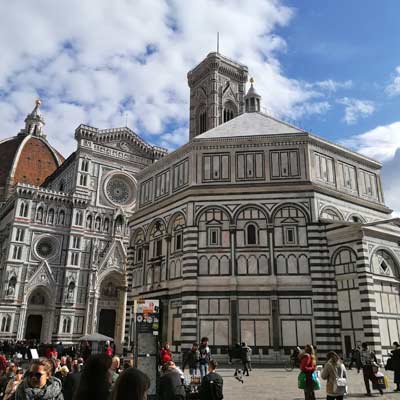
The Duomo has a gothic design, but the façade is covered in red green and white marble
Hop between the charming plazas and Art Nouveau neighbourhoods of Riga with help from this curated itinerary. It lasts two days and includes most of the mainstream sights and some hidden extras for good measure:
Day 1: Breeze straight into the Riga Old Town. This medieval maze of a district is a fairy-tale place to be. It's also got a glut of sights. Start on the square topped by Saint Peter's Church. The oldest Christian building in the city, it's been rebuilt and reconstructed many a time.
You can scale the 120 or so metres to the top of the spire to get 360-degree views of the river, the capital, and even the Baltic coast. Back on ground level and a few streets over, you can see beautiful Town Hall Square. The most eye-catching building in the city looms on one side.
It's the so-called House of the Blackheads, where rich bachelor merchants held court for several hundred years. Delve inside for exhibits that unravel the enthralling past of the city since the age of the Hanseatic League.
Move northwards through Dome Square to have sunny lunches under the handsome cathedral building. Then push on to Riga Castle. First raised in 1330, it's gilded with additions that were built by the Swedish invaders of Latvia.
As evening closes in, you could opt to join the famous Riga Pub Crawl. They hit a number of underground Latvian taverns and then a pumping club.

The cobbled streets of Riga’s old quarter
Day 2: Hangover or not, you should rise early and make for the western area of Miera Iela. The cracked-plaster façades of the old buildings there herald what's surely the most hipster and creative corner of the city. Students and young professionals are everywhere, and there are some top brunch spots to kick start your morning. Then bear eastwards, back towards the Old Town.
On the way, you'll have to navigate Centrs district. Your first pitstop should be Alberta 12, where a grand edifice decorated with statues of nymphs and floral motifs commands the attention. It's one of the finest examples of the Art Nouveau style for which Riga is famous. Inside, you'll even find the Riga Art Nouveau Museum, which chronicles the architectural and design style from the turn of the century onwards.
Lunch can be had in the new town area to the south – Dzirnavu Iela especially has some charming café-bars and great shopping. The pretty walking paths of Vermane Garden can be perfect for an afternoon stroll if the sun is shining. They will take you all the way to the vibrant Pilsetas kanals garden, the home of the town's padlock-covered love bridge that's in good proximity to some hearty Old Town taverns for dinner.

The freedom Monument – the three stars represent the three regions in Latvia

The Art Nouveau on the Alberta 12
48 hours in Florence
Early morningstarts are key in Florence, to hit the galleries and basilicas before the crowds. Don't worry, though, this two-day itinerary has time to rest with beautiful views in Renaissance gardens come the afternoon…
Day 1: Make for the Piazza del Duomo for the break of dawn – seriously, the earlier you can get there the better. That way, you can snap shots of the great cathedral and adjacent Giotto's Bell Tower without plumes of visitors getting in the way!
Look to the green-white marble inlays and the striking Gothic Revivalism of the whole building and think about hitting the 87-meter high lookouts of the belfry for some sweeping views across the city and the Apennines.
Traditional Tuscan design oozes from the lovely Palazzo Vecchio on Piazza della Signoria – this is the town hall, dating from way back in the 1400s. Grab an on-the-go pizza slice and make north to Galleria dell'Accademia after that.
A quick in and out there should be enough to appreciate the wonderful David statue by Michelangelo, before hopping back to the riverside and crossing the Ponte alle Grazie (have the camera ready).
For sunset, a climb to the Piazzale Michelangelo is a must. The panoramas include the Tuscan hills and the pastel-painted tops of the city, which look stunning as the light dips low.
For dinner try the regional meal of Bistecca alla Fiorentina (Florentine steak).

The shops along the Ponte Vecchio traditionally sold jewellery
Day 2: It's a museum morning in the famous Uffizi Gallery on day two. For art lovers, the journey here is a rite of passage. The collections span several wings of a great palace in the heart of central Florence and can take hours on end to appreciate fully.
Highlights that simply can't be missed include The Birth of Venus (Botticelli), Laocoön and his Sons (Bandinelli), Raphael's portrait of Pope Leo X, and Caravaggio's unforgettable Medusa. Back outside, the Ponte Vecchio bridge isn't far. It was once a butcher's market but is now famous for its jewellery boutiques.
On the hills beyond are the handsome Boboli Gardens, all brimming with babbling fountains and carved statues. Further up again is Forte di Belvedere, where even more breathtaking views of Florence are on offer come the evening.
Related articles: Florence in 2 days

The Uffizi Gallery exhibits the greatest collection of Renaissance art

The statue of David is regarded Michelangelo finest work
Florence
The best place to touchdown on a flight is surely Amerigo Vespucci International Airport. A mere 15 minutes' drive (7km) in a taxi, or 30 minutes in a train, can link you from the downtown to the terminals there.
Unfortunately, the bulk of Europe's budget carriers will jet into Pisa. That's still close – around 1-1.5 hours (83km) in the bus to the west.
Avoid flying into Bologna, as this is even further away (115km), and bus transfer 1.5-2 hours.
You definitely won't have to worry about finding somewhere to stay. From slick boutique hotels to simple hostels, Florence has all sorts. The town's primary industry is tourism, after all. Just expect prices to soar in the middle of the summer, before dropping again around the start of September.

The Piazza della Signoria
In terms of neighborhoods, you'll want to focus on bedding down within the SS67 ring road. More specifically, the districts of San Giovanni (the historic core) and Santa Croce are perhaps the most central, even if the latter retains a lived-in Italian feel. San Marco is a whisker to the north, hosting the bulk of the low-cost hotels and guest houses. Oltrarno boasts buzzy nightlife venues and hip coffee shops.
Related articles: Where to stay in Florence?
You probably won't need any forms of transport in Florence other than your own two feet. The town is eminently walkable. Be sure to bring comfy shoes that are suited to long days, however, especially if you're keen to scale to the lookout points around Piazzale Michelangelo.
For exploring the surrounding region, a rental car is a must. These tend to be cheap in Italy and are best organised from the airport to avoid driving through the centre of town.
Aside from the infamous Stendhal syndrome – a condition supposedly caused by exposure to too much beautiful Florentine art – there are no standout risks to visiting this city. The centre is generally safe and well maintained, crime rates are relatively low, and the locals are often happy to help out.
Riga
Riga International Airport is the largest in all of the Baltic states. It's served by flights originating all over Europe, in Russia, and even the Middle East. Bus 22 and plenty of private taxi firms offer connections to the city, though you'll need to be wary of scam drivers who often crank up the price to €80 or more! The trip to the downtown from the terminals usually takes no more than 30 minutes.
You shouldn't need to deal with any public transport on a city break to Riga. The town is nice and compact, so a good pair of shoes and a willingness to walk is usually enough to get around. That said, there are streetcars, buses and minibuses on the same network. Grab yourself an e-talons ticket to use the lot. Each ride costs €1.15 and needs to be renewed if you transfer.
You'll almost certainly want to seek out a hotel in Riga Old Town. That will put you right in the thick of the action. We'd recommend steering clear of Audēju Iela, though.
It's vibrant and lively, but the pumping bars can make it hard to sleep at night. Quieter areas include the northern portion of the district and the streets around Riga Castle.

Riga castle is official residence of the Latvia President
Keep your guard up when walking around Riga, particularly after dark or a few beers. The capital is generally safe, but areas like Maskavas Forštate should be avoided. Pickpockets and petty theft, along with taxi scams, tend to be the biggest dangers of all.

oh we were stuck in the airport!

Copenhagen was a bit expensive...

All we did was drink beer in Brussels...

Muncih was crazy

And we got so burnt!

Remeber that night in Rome

oh we were stuck in the airport

So much fun kayaking

Berlin and that group from Austria!

There was such a view from that church

And we got so burnt!

Munich was eventful, wasn't it!

Such a view from that cathedral in Florence

Lisbon was such so much fun

Last summer was so much fun .... x

Remeber that night in Rome

Lisbon was such so much fun

Such a view from that cathedral in Florence

Munich was eventful, wasn't it!

And we got so burnt!

Remeber that night in Rome

All we did was drink beer in Brussels...

Berlin and that group from Austria!

Can't wait to go back to Dubrovnik

Remember that boat ride in Prague

Copenhagen was a bit expensive...
